How to Make Soft Scones
This post may contain affiliate links. Read the full disclosure here.
Every day is perfect for scones, and this tutorial will walk you through exactly how to make soft scones. These scones come out crisp on the outside and super soft and light in the middle. They are incredible!
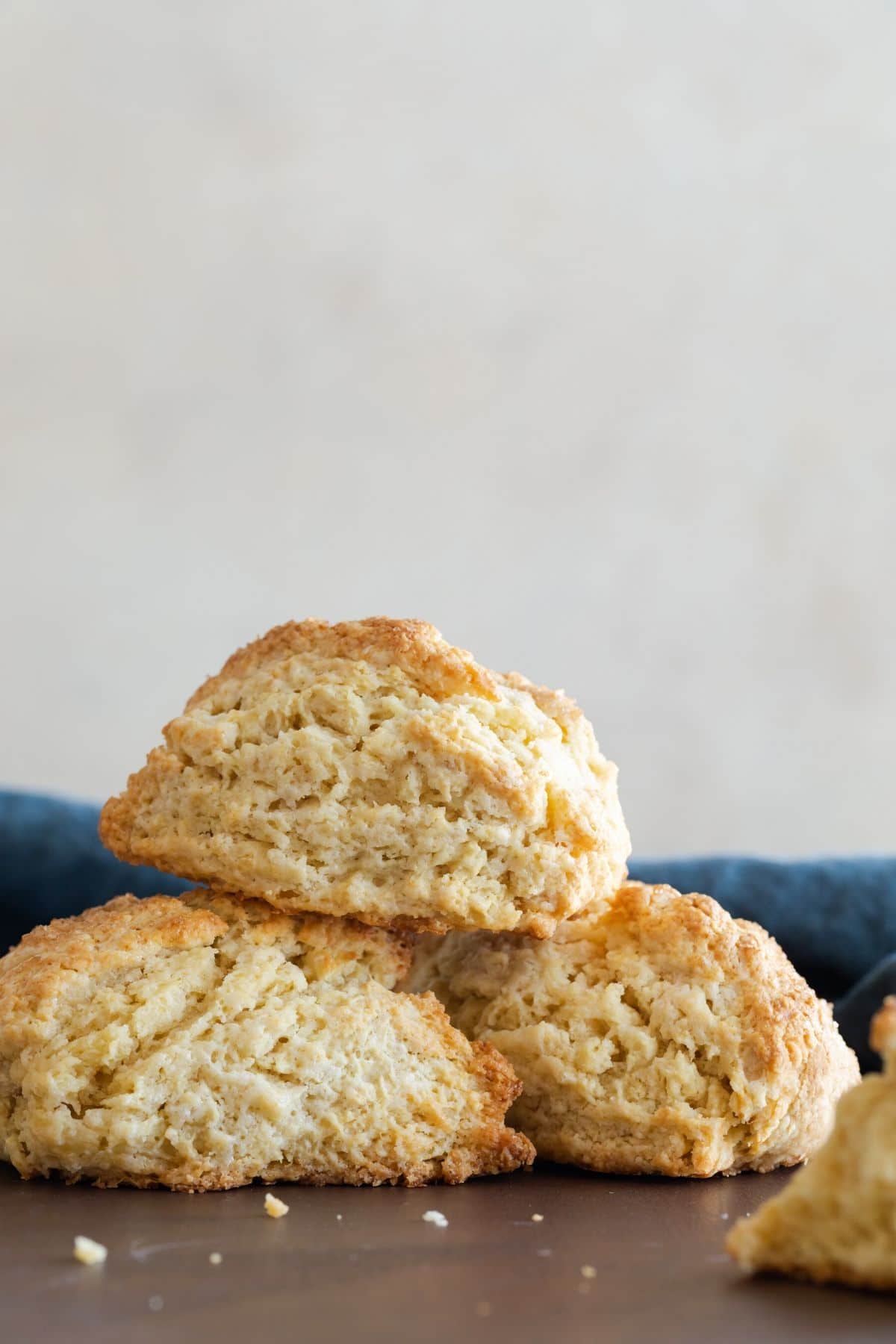
The best scones can be made at home
I’ve made a lot of scones over the years. Enough to say I’ve mastered the recipe for big fluffy scones. They are one of my favorite baked goods.
Once you have a plain scone recipe, you can create many variations with that one recipe.
I’ve used this base for vanilla cardamom scones, chai pear scones, blueberry buttermilk scones, lemon cream cheese scones with strawberries, and so much more. It’s fantastic with dried cranberries.
So I thought why not give you this soft scone recipe along with my best tips and tricks for incredible scones. Use it to create your own fun flavors!
Why this recipe works
- Using buttermilk helps keep the scones ultra-tender.
- Freezing the scones before baking will ensure the butter is cold which is what creates the airy pockets within the scones.
- Adding an egg will keep them make rich and soft.
- You don’t need to use the full amount of liquid. Only add as much as needed for the dough to stick together.
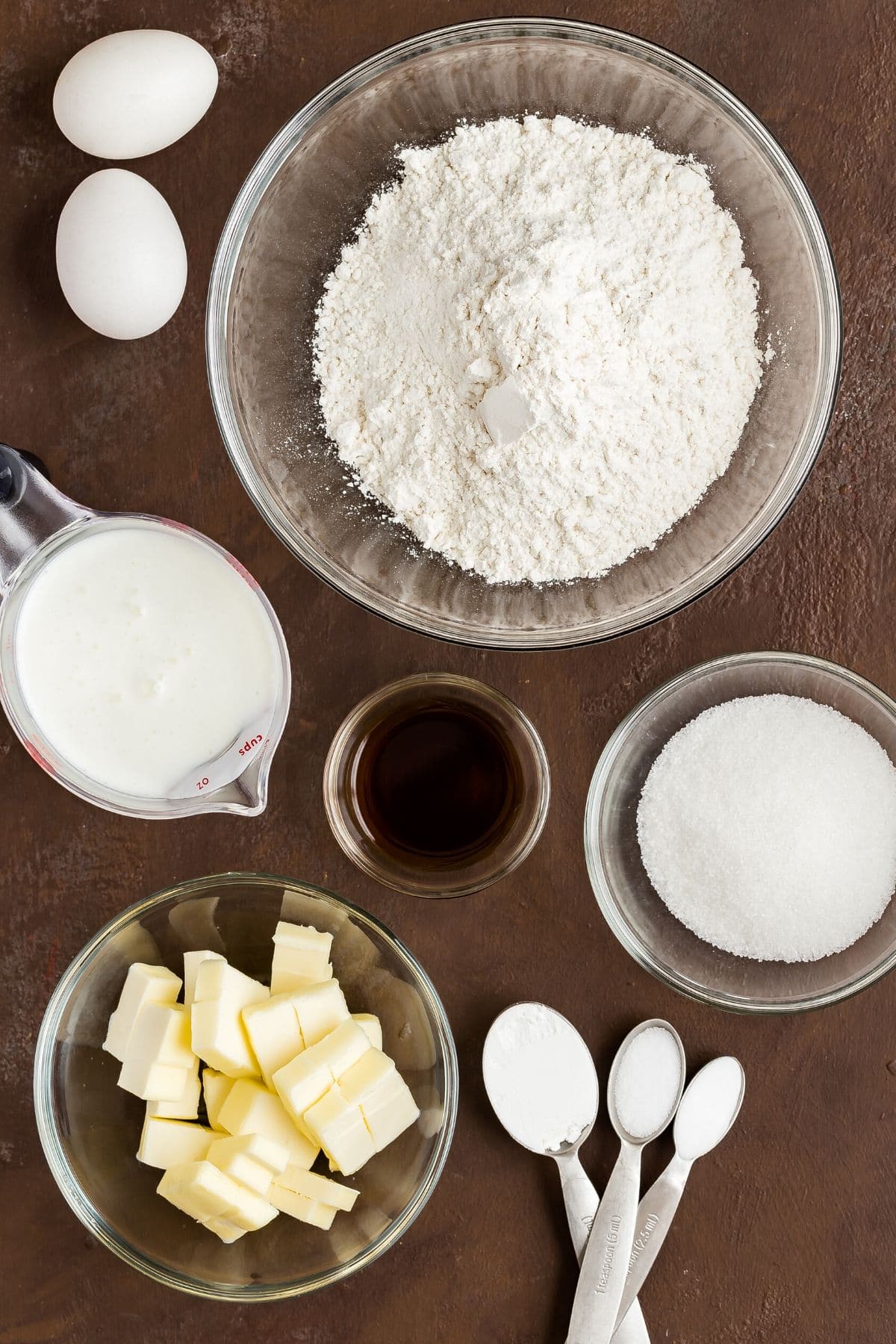
How to make scones
These American Scones take only about 20 minutes to bake and you can pretty much eat them straight from the oven.
You’ll notice that this recipe calls for one egg. Sometimes I’ll use an egg and sometimes I won’t. I think the egg adds a little extra richness that is needed for a simple scone without much flavoring.
If you want more of a traditional English scone, you can try my homemade biscuit recipe instead.
Make the dough – Combine flour, sugar, baking powder, baking soda, and salt in a large bowl then use a pastry blender to cut the cold butter into the dough. Combine buttermilk with egg and vanilla and mix a little at a time into the flour.
You won’t need all the liquid. Just add as much as you need to get the dough to stick together without being wet.
Once you’ve combined the wet and dry ingredients, stir gently until the dry ingredients have become moistened. Don’t stir anymore beyond this point. Instead, turn the dough out onto a lightly floured surface and knead it gently four or five times until it comes together.
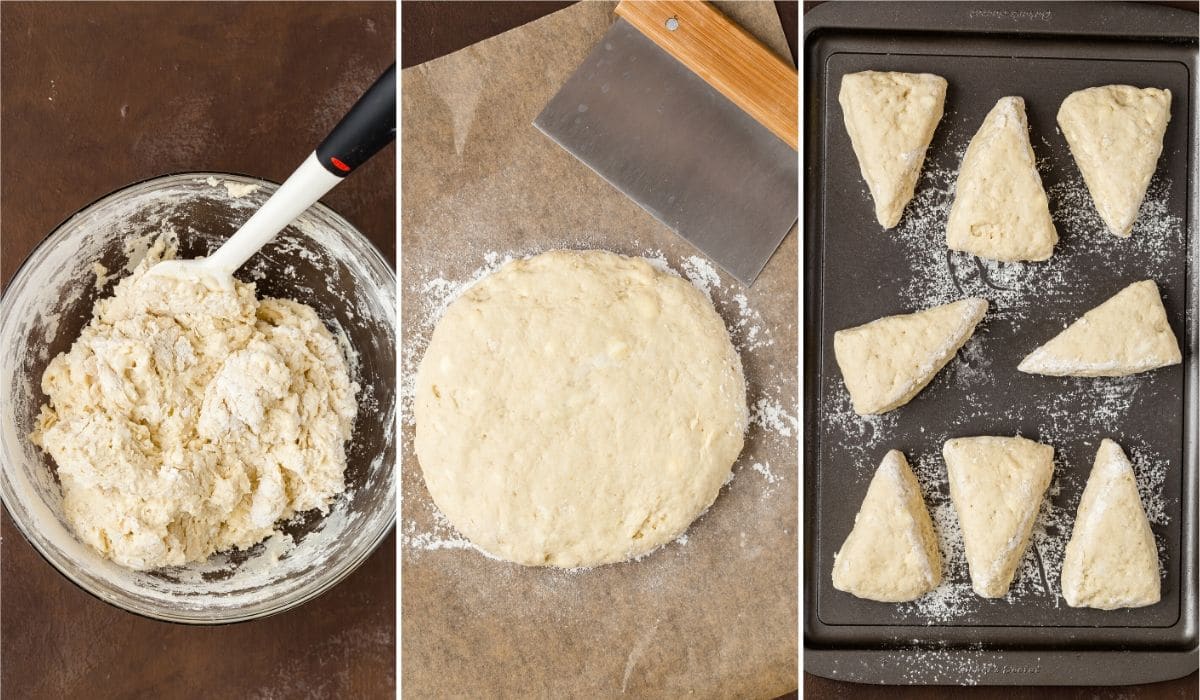
Shape the dough – Pat the dough into a 7-inch round circle. Cut the circle into 8 triangles. It’s easiest to do this by cutting the circle in half, then cut each half. Continue this until you have 8 sections.
Freeze the dough – For super a soft texture, it’s important to keep the dough cold. Use cold ingredients and handle the dough as little as possible with your hands. After shaping the scones, place them on a baking sheet and pop them into the freezer for 20 to 30 minutes.
The steam from the melting butter creates air pockets which will make the inside tender and light. So so good!
Bake – Brush the tops with heavy cream or milk and sprinkle coarse sugar over them. Bake for 15-20 minutes until they are golden brown. Let them cool then serve them with butter, jam, or clotted cream.
Recipe variations
- Mix in ¾ to 1 cup of your favorite add-in. (fresh or frozen fruit, dried fruit, chopped nuts, chocolate chips, etc.)
- Add 1 tablespoon of lemon or orange zest.
- Use ½ cup orange juice and ½ milk in place of buttermilk.
- Add 1 to 2 teaspoons of your favorite extract in addition to the vanilla.
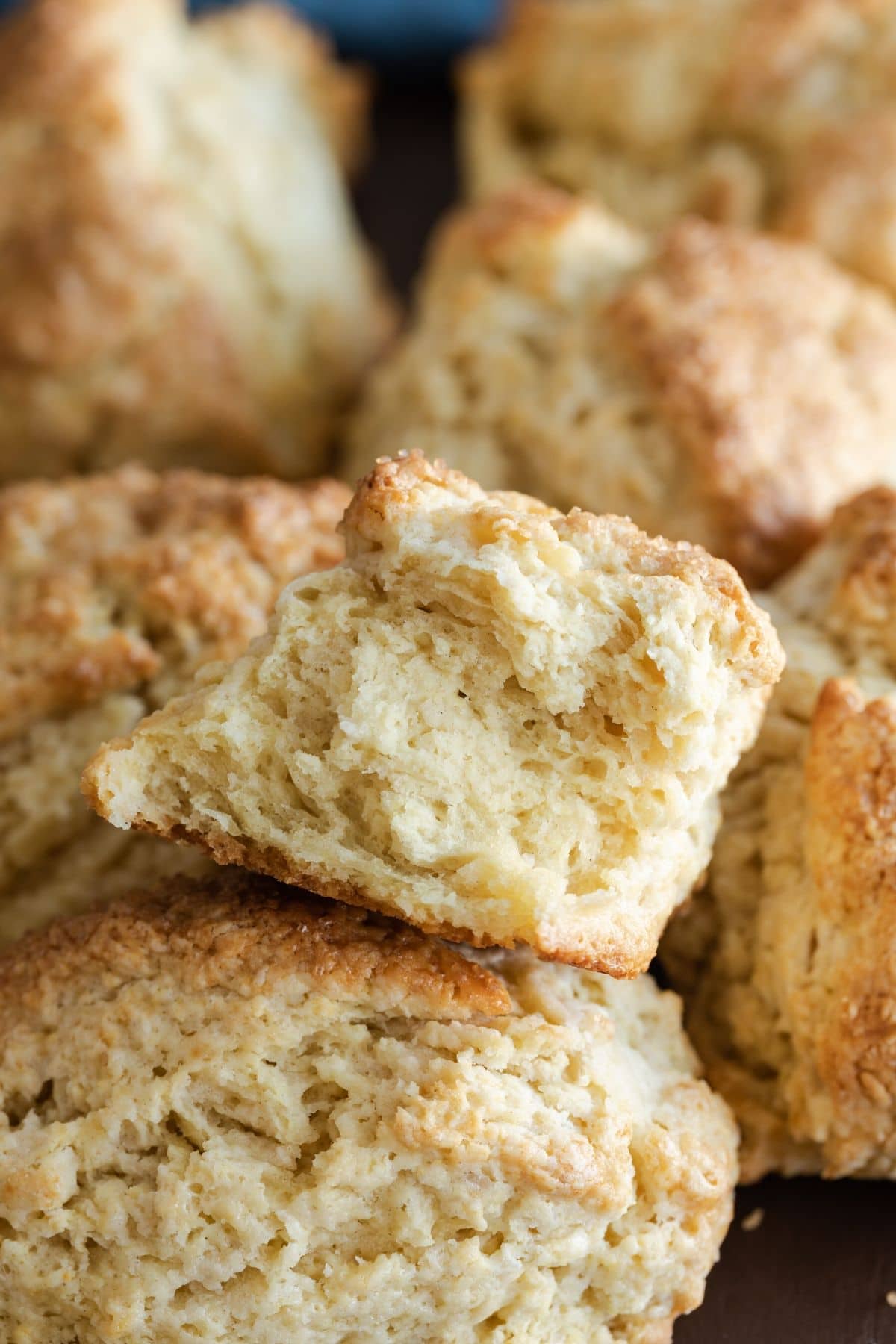
Common questions about soft scones
What’s the rule of thumb with adding fruit to the batter?
I generally stick to adding 1 cup of any mix-in. You can add a single ingredient or a combination of fresh fruit, dry fruit, nuts, etc.
Toss them in before you add the wet ingredients and then mix everything together. There’s no need to adjust any of the ingredient amounts.
Can the scones be made without sugar?
Yes, they certainly can. My recipe calls for sugar because I live in the US and this is how we make them. But other places like the UK don’t add sugar to their scones. So, it just depends on what you prefer.
Can I make the dough and freeze it for later use?
Scone dough will freeze well! Make and shape the dough. Place them on a baking sheet and freeze them for an hour. You can then transfer them to a freezer-safe container or ziptop freezer bag.
They’ll keep for up to 3 months. Bake them straight from the freezer but add a couple of minutes to the bake time.
Can you use half & half in place of milk?
You can use half and half or any milk substitute in place of milk.
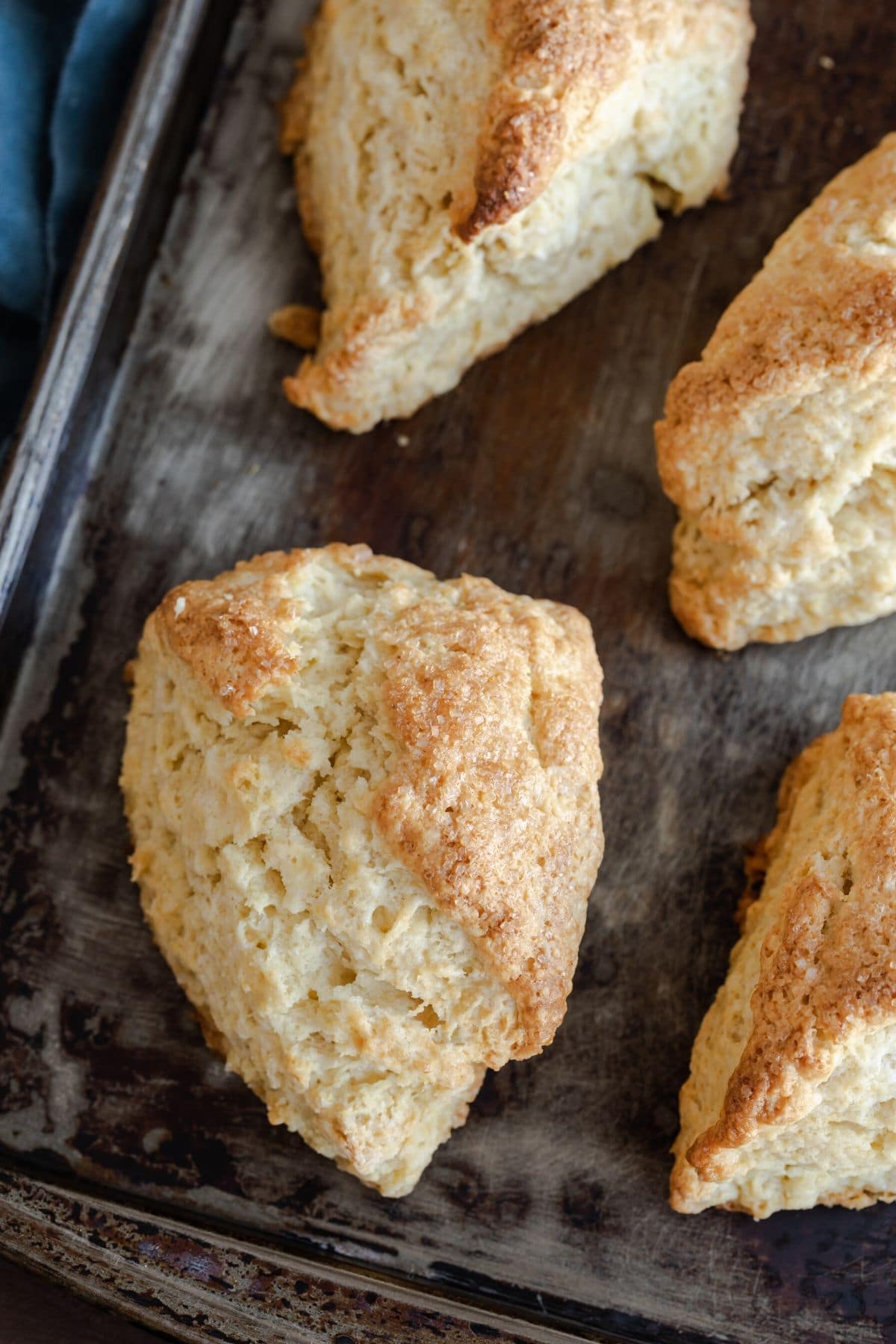
Tips for perfect soft scones:
- When kneading the dough, work quickly so the butter doesn’t melt from the warmth of your hands. It’s crucial that all the tiny bits of butter stay intact.
- Add only as much liquid as it takes for the dough to come together. The dough shouldn’t be wet, but it should stick together when you squeeze it.
- They are best enjoyed the day they are made. Place the leftovers in an airtight container and store at room temperature or in the refrigerator for up to 2 days.
- You can freeze them for up to 3 months.
If you like this English Muffin recipe, try these other breakfast recipes:
- Peach Scones with Almond Glaze
- Carrot Cake Scones
- Sweet Potato Scones with Brown Sugar Glaze
- Pumpkin Scones
- Honey Citrus Sweet Potato Scones
Soft Scones Recipe

Ingredients
- 2 ¾ cups (358 g) all-purpose flour
- ⅓ cup (67 g) granulated sugar
- 1 tablespoon baking powder
- ½ teaspoon baking soda
- ¾ teaspoon salt
- ½ cup (113 g) unsalted butter, cold and cut into pieces
- 1 cup (240 ml) buttermilk, cold
- 1 large egg
- 1 tablespoon vanilla extract
- 1 tablespoon heavy cream, or milk
- 2 tablespoons coarse sugar
Instructions
- In a large bowl, whisk the flour, sugar, baking powder, baking soda, and salt together.
- Cut the butter into the flour using a pastry blender, 2 knives, or your fingertips. The mixture should look like coarse crumbs.
- Whisk the buttermilk, egg, and vanilla together and gradually add it to the flour mixture. Stir just until the dough comes together. You may not need all the buttermilk. Add a little at a time until the mixture is moist but not too wet. Do not over mix the dough or the scones will be tough.
- Transfer the dough to a lightly floured surface and gently knead the dough four or five times. Pat the dough into a 7 inch round circle.
- Cut the circle in half, then cut each half into four triangle shaped wedges. You should have 8 triangles.
- Arrange the scones 2 inches apart on a baking sheet lined with parchment paper. Place the scones in the freezer for 30 minutes.
- Position the oven rack in the center of the oven and heat to 400°F.
- Brush the tops of the scones with milk or cream and sprinkle with coarse sugar. Bake for 15 to 20 minutes or until golden brown. Transfer to a wire rack to cool. Serve immediately.
Notes
- The scones need to be cold when going into the oven. Placing the shaped dough into the freezer for 30 minutes ensures the scones will bake up light and fluffy.
- Alternatively, you can place the scone dough in the refrigerator for at least 2 hours.
- Mix in ¾ to 1 cup of your favorite add-in. (fresh or frozen fruit, dried fruit, chopped nuts, chocolate chips, etc.)
- 1 tablespoon of lemon or orange zest.
- Use ½ cup orange juice and ½ milk in place of buttermilk.
- Add 1 to 2 teaspoons of your favorite extract in addition to the vanilla.
- Unbaked scones can be refrigerated overnight. Or seal in an airtight container and freeze for up to 1 month. Add about 2 minutes to the baking time when baking from frozen.
- Baked scones will keep for up to 2 days stored in an airtight container at room temperature or in the refrigerator.
- Scones can be frozen for up to 3 months. Thaw in the refrigerator overnight.
Nutrition
The nutrition information provided is for convenience and as a courtesy only. It is not guaranteed to be accurate because nutrition information can vary for a variety of reasons. For precise nutritional data use your preferred nutrition calculator and input the exact ingredients and brands you used in the recipe.

Can these be made eliminating the sugar? I made these the other day and they were the best I’ve had since I was living in the UK. I have a friend who is diabetic so I wanted to make these without sugar-
They definitely will not taste as good without sugar. Maybe try a sugar substitute instead of omitting it altogether?
Can these be made eliminating the sugar? I made these the other day and they were the best I’ve had since I was living in the UK. I have a friend who is diabetic so I wanted to make these without sugar-
I do believe this page recommended to freeze the SCONES when you have shaped them, for about a half an hour just before you put them in the oven! And hey this eliminates any mixing etc. issues!
I do believe this page recommended to freeze the SCONES when you have shaped them, for about a half an hour just before you put them in the oven! And hey this eliminates any mixing etc. issues!
What would the rule of thumb be for adding things to this mixture? Like chocolate chips or fruit? Can i use this as a base recipe for any kind of scone with any kind of dry mix ins?
Thanks!
This recipe is perfect for all sorts of add-ins. I generally stick to 3/4 to 1 cup of add-ins and this works well for fresh, frozen, or dried fruit, chopped nuts, chocolate chips, cinnamon chips, etc.
Hmmm those look lovely but not much rise there. I agree freezing the butter and grating is a complete waste of time. By the time you’ve grated the butter it’s defrosted already as the little flakes of butter thaw almost instantly unless one is working inside an industrial freezer.
The butter doesn’t have to be icy even, it’s easier to mix it into the crumble stage with the flower if its slightly room temp, and mix you must. Again by the time you’ve done rubbing the flour and butter those previously frozen flakes or the chilled butter is going to be room temp anyway.
Getting the right consistency to your dough is really what it’s all about. Not overworked, not too moist, not too dry. It’s all in the feel. Texture and rise are the most important issues in a scone which have after all so little by way of ingredients.
Thank you so much for sharing all this thoughtful feedback. The scones will rise taller if you bake them closer together!
What is the rule of thumb for adding fruit in – do I change the dry or wet ingredient amounts? What about pumpkin?
I typically add 1 cup of fruit and keep the remaining ingredients the same. Follow the instructions in step one for adding the wet ingredient. Use just enough to make a moist but not wet dough.
You can adapt this sweet potato scone recipe to use pumpkin.
What is receipe for the glaze please.
You can make a simple glaze by mixing 1 cup of powdered sugar with 1-2 tablespoons of milk or cream and 1/2 teaspoon vanilla.
Can you use half & half in place of cream or milk
You certainly can.
Scones are definitely a favorite of ours! We’ll have to try this recipe!